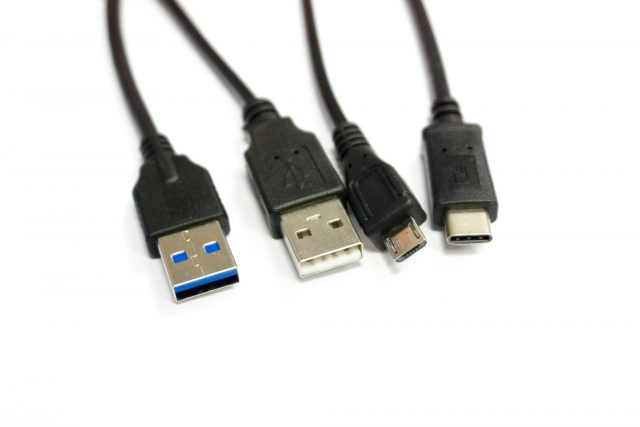USB Type-C debuted earlier this year, with Apple’s new MacBook and Google’s Chromebook Pixel amongst the first devices to sport the new connector. The most notable enhancement with Type-C is that the connector is reversible, so you don’t need to figure out which way the plug goes in. It was supposed to make USB cables much easier to work with. But is it?
When I got my first USB Type-C gadget, the first obvious problem was that I needed adapters, because I had no other Type-C capable devices. I didn’t mind this at all. I appreciate that making a connector that wasn’t reversible into something that is now reversible may present some physical difficulties. It’s not like USB 3.0 Type-A connectors, which were backward compatible and interoperable with their USB 2.0 brethren. It is different with Type-C.
The silliness, however, is that while I still had micro-USB cables around, I can’t easily differentiate them from the Type-C ones. They look too similar. It’s not easy to tell them apart if you only take a quick glance. Now, I actually have to look at the connector to know which one I’ve got. I can’t see them in the dark, so I’ve to touch and feel the connector to tell them apart, but by that time, if it were micro-USB, I can already determine it’s orientation. There’s still the small benefit, of course, that I don’t need to know the orientation of the port on the device itself, as it seems there is no standard orientation of micro-USB ports.
Still, change is for the better. I thought they could have made the connector more different from micro-USB. But I suppose the people who make the USB standards didn’t think too much. Perhaps that’s alright. We will eventually be rid of micro-USB.
However, that’s not all there is to Type-C. It’s gotten quite messy. The USB Implementers Forum, the body that makes the specifications, seemed to have made USB unnecessarily confusing. I didn’t know, until I read up while trying to understand more about charging and USB 3.1.
First, about USB 3.0. Did you know, USB 3.0 is now known as USB 3.1 gen 1? That what you had thought is USB 3.1 is now USB 3.1 gen 2? I don’t know, what is wrong with 3.0 and 3.1? USB-IF somehow felt this version naming was better.
I had also thought, when OnePlus introduced the Two with Type-C but not USB 3.0 (or 3.1 gen 1 as it should now be called), that they were simply trying to cut cost. Well, apparently not. Type-C does not imply USB 3.1. It can still be USB 2.0. Google’s new Nexus 5X and 6P, both having Type-C ports, are also not of USB 3.1 variety.
Next, about the Nexus 5X and 6P again, their Type-C supports rapid charging, but they are not Qualcomm Quick Charge 2.0 compatible, or any Quick Charge version thereof. That’s because Type-C itself supports higher power delivery, thus allowing faster charging. This is how Apple’s new MacBook can be powered via its Type-C port. Type-C is neat, because it has this new thing called USB Power Delivery, which can push up to 100 W of power. Yes, 100 W.
But, USB Power Delivery is optional. Apple’s new MacBook supports USB Power Delivery. The Nexus 5X and 6P do not. However, without USB Power Delivery, Type-C can do 15 W in its base specifications. This is the rapid charging that the Nexus 5X and 6P supports, but it will only work with Type-C chargers such as the ones provided by Google, not existing Type-A chargers via Type-A to Type-C adapters.
To be clear, without USB Power Delivery, and without Qualcomm Quick Charge, the maximum permissible power supported by USB is 7.5 W, under the USB Battery Charging 1.2 standard. The Nexus 5X and 6P support neither USB Power Delivery nor Qualcomm Quick Charge. Even tech sites like Tech Times get this wrong (Nexus 5X And 6P Phones Have USB Power Delivery Via USB Type-C, But They Don’t Support Quick Charge 2.0).
In case you’re wondering, that new MacBook’s Type-C is USB 3.1 gen 1, not gen 2. Gen 2 supports 10 Gbps bandwidth, up from 5 Gbps in gen 1 (or what you had known as USB 3.0).
Qualcomm’s Quick Charge 2.0 can be supported on Type-C. Indeed, the Nexus 5X and 6P appear to actually contain the Quick Charge chip, but it’s somehow not used.
What a mess.
In summary:
- USB 3.0 is now known as USB 3.1 gen 1, supports 5.0 Gbps
- USB 3.1 is now known as USB 3.1 gen 2, supports 10.0 Gbps
- Type-C refers to the connector, and can either be USB 2.x or 3.x
- USB Power Delivery is optional, supports up to 100 W
- Nexus 5X and 6P charges at 15 W with a Type-C charger, does not support Qualcomm Quick Charge
Ref:
- The new standard: USB Type-C
- USB Type-C. Power Delivery. USB 3.0. Which ports are capable of what features?
- Explaining the “USB 3.1 Gen 1” port in the Retina MacBook

Yea, Type-C is in a mess! Even with the power output. 2.4A vs C-C of 3A.